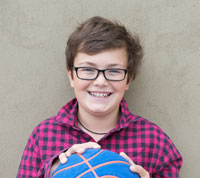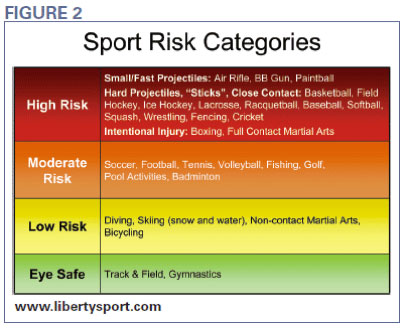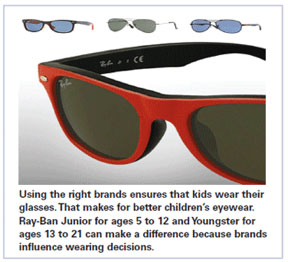HOME PLATE
Probably the toughest part of our job is communicating the importance of the right outdoor eyewear and sport eyewear to parents. Fitting children offers a unique sales problem. We can't lose sight of the fact that even though the child is our patient, he or she is not our customer. In most sales situations, the patient and customer are the same person, but our real customer is the parent and most often Mom. We have to convince Mom that sport eyewear is worth the price by explaining what they are actually doing.
Nearly every parent who walks into my office is worried about little Johnny ruining his glasses when he's playing sport in his fashion eyewear. The frames could be broken by being knocked to the ground and stepped on. They never recognize the fact that ruining his glasses is inconsequential to the risk of ruining his eyes when he's playing sports. It's hopeless trying to justify the purchase of a $250 pair of sport goggles to protect a $250 pair of street eyewear. However, the balance changes dramatically when you point out that sport eyewear isn't designed to save his glasses, they are designed to save his sight.

I often remind parents and kid how they are required to wear mouth guards, even though, honestly, false teeth could work as well as real teeth. If we are so focused on protecting our teeth, what about protecting our eyes? "False eyes don't work nearly as well as false teeth." When you frame things in that light, parents will find it hard not to place a high value on the only two eyes their child will ever have.
SPORT BANDS?
The other requests often asked is, "Couldn't my child just use an elastic sport band that would hold the glasses on more securely?" This is something that greatly distresses me. A sport band is a group of people marching on the field at halftime, blowing their trumpets and beating drums. When we put an elastic strap on the back of metal or plastic glasses, we increase the tension on the bridge of a frame that probably already isn't strong enough to withstand an impact. If the bridge breaks with the sport band pulling back on the temples, it will pull the frame directly into the face. When that happens, the patient is likely to sustain some kind of eye injury or, at the very least, abrasions on the face. So let's leave the band to the sidelines.
THREE-POINT PLAY
Did you notice the great parental misconception above? The family wanted to purchase sport frames and sport bands to save their child's fashion eyewear. This assumes that sport eyewear's main purpose is to replace existing glasses, which is inaccurate. Their main purpose is to protect eyes that are at risk during dangerous activities. Once the optician's mindset switches over from replacement to risk mitigation, we begin to see that many more young patients will benefit from wearing sport frames.
When assessing risk, we need to evaluate the type of sport, the kind of play and the skill (or lack of skill) of the players. Every family with children in contact sports should be encouraged to consider sport eyewear. This includes not only those with corrective eyewear, but also those wearing contact lenses and even those who do not wear corrective lenses at all.
What is a contact sport? A contact sport is technically defined, as any sport where there is the potential for physical contact between players or a sport that has moving projectiles, like baseballs, hockey pucks and paintballs. Contact may be between players or with inanimate objects.

The first category of athlete in the chart (Fig. 2), those wearing corrective eyewear, enjoys clear benefit from sport eyewear. Consider this: In a contact sport, glasses are just another potential projectile, but one that is positioned a quarter-inch away from the player's eyes. All players have an equal risk with unprotected eyes, which is bad. But a competitor wearing glasses has the added risk that their eyewear becomes a secondary projectile resulting from the original collision.
What if we take away the glasses entirely? I have many young children who grow into their teens and naturally move on to contact lenses. Contact lenses have advantages over glasses because they have a wider field of vision, and I understand the freedom that the athlete experiences when wearing them. It may also have a small advantage that it provides a tough membrane over the cornea, which could prevent abrasion during direct contact. However, in the long run, there is an increased risk of corneal abrasions from dirt and other debris getting under the contact lenses during play. Obviously, the child has no protection from impact during play. This type of protection will only be afforded by wearing the proper sport eyewear.
This brings us to the last category regarding the frame, i.e., athletes who do not wear any type of corrective lenses at all. Although wearing glasses or contact lenses doesn't increase their risk, clearly their risk has not been decreased at all. Anyone engaging in sports, particularly contact sports, is at risk.
When families come in and only one of their children wears glasses, I am quick to let them know that their other children are at risk too when they play without sport eyewear. It's our duty to inform and help patients and parents make educated decisions. It's up to them should they choose not to, but if we choose not to tell them, then we have not done our duty. Most parents don't want to send one kid on the field with a risk reduced by 90 percent and send the other out without any protection at all.
IN THE HUDDLE
Mom and Dad understand the benefits of sport eyewear; little Johnny is confident going out on the field because he knows he is well protected. Now we can "spread out the defense" by finding other ways to use the sport glasses. Sport and protective eyewear can be worn in many other places than just traditional sport venues. Don't be afraid to let them know that they can be worn for riding a bike, on the playground and at recess, sledding, even on roller coasters. Their new sport eyewear can also serve as a backup pair of glasses, and if they decide to use photochromic lenses, this can also be helpful until the budget allows a quality, great pair of sunglasses.
Once parents are on board, it's crucial the child understands all the benefits to wearing sport eyewear. After all, the glasses are only good if the child will wear them. Fortunately, goggles are not what they used to be. In fact, I make it a rule to never even call them goggles. "Goggles" sounds silly and ridiculous, who could ever take that word seriously? Gargle, giggle, goggles. In my office, we call it sport eyewear or sport glasses.
On a cosmetic level, we can now offer some pretty sweet-looking sport eyewear. Liberty Optical's line of RecSpecs come complete with a variety of colors, even team colors. You can also find a wide variety of Leader brand sport eyewear by Hilco. On the other hand, we don't want the kids to just look good—we want them to feel good about wearing them.
This is when it's time to huddle up and really show off the features. Let your little friend know just how protected his or her eyes are in this new high-tech sport eyewear. Tell them that the sport eyewear absorbs the impact and keeps that impact from transferring to the head and eyes to make it a less painful experience. Most kids will identify with getting hit or knocked down while playing. Let them know they can feel safe and are safer than the other players on the field who aren't wearing sport eyewear. I have found that kids who normally would shy away from getting hurt or breaking their regular glasses now enjoy a freedom that allows them to play more competitively. What competitive kid doesn't want to know he or she has an advantage on the field over other players?

BRANDS
Brands also influence children and their parent's decisions. For non-contact sports that do not require ASTM-certified frames, the driving force is appeal. Brands make a difference—use them in your practice. Kids will want to wear the glasses that their older siblings like so use junior versions of the popular aviator and Wayfarer styles.
LENSES
Lenses are the other half of sport eyewear protection. Lenses must be polycarbonate for ASTM impact compliance and therefore will also be 100 percent UV-absorbing. For other non-ASTM covered sports, polycarbonate and Trivex material are the material choices. Remember that the child's eye is more transparent to UV radiation so quality, outdoor lenses like photochromics and polarized lenses, make a real difference. For more background about UV and children, visit 2020mag.com/CE for the CE "A Focus on Kid's Eye Health."
THE LAW
States are slowly taking up legislation about sport eyewear and a few, like New Jersey and Florida, are passing non-penalty laws requiring sport eyewear. There is no good reason for opticians to be waiting for governmental involvement. As an industry, we have accepted that polycarbonate or Trivex lenses are the preferred material for children's eyewear because they are the safest lenses available. Clearly, we already recognize that children are inherently at a greater risk. It is only a natural extension of this to recommend sport eyewear for all children engaging in sports.
To take the American Board of Opticianry (ABO) certified test related to this topic, please click here.

Danielle Crull, ABOM, owns A Child's Eyes, an independent optical store specializing in pediatrics in south central Pennsylvania. She became a Master Certified Optician in 1997, and her thesis topic concerned the differences between dispensing to children and adults. She lives in Dillsburg, Pa., with her husband and three children, all of whom work in her business.













